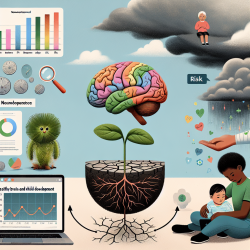Introduction
In the realm of speech-language pathology, data-driven decisions are pivotal in tailoring interventions that yield optimal outcomes for children. The recent advancements in mass spectrometry, as detailed in the research article "Advances in Structure Elucidation of Small Molecules Using Mass Spectrometry," offer promising avenues for enhancing therapeutic practices in speech-language pathology.
Understanding Mass Spectrometry
Mass spectrometry is a sophisticated analytical technique used to determine the composition of molecules. It provides detailed insights into molecular structures, which can be crucial for understanding the biochemical underpinnings of speech and language disorders. By leveraging mass spectrometry, practitioners can gain a deeper understanding of the molecular profiles associated with various speech and language impairments.
Applications in Speech-Language Pathology
The integration of mass spectrometry into speech-language pathology can revolutionize the way we approach therapy. Here are some potential applications:
- Biochemical Profiling: By analyzing the biochemical markers associated with speech and language disorders, practitioners can develop more targeted interventions.
- Early Detection: Mass spectrometry can aid in the early detection of speech and language disorders by identifying specific molecular markers, allowing for timely intervention.
- Monitoring Progress: Practitioners can use mass spectrometry to monitor the biochemical changes in response to therapy, providing a quantitative measure of progress.
Encouraging Further Research
While the current research provides a strong foundation, further exploration is needed to fully realize the potential of mass spectrometry in speech-language pathology. Practitioners are encouraged to engage in collaborative research efforts to explore the following areas:
- Longitudinal Studies: Conduct studies to track biochemical changes over time in response to different therapeutic interventions.
- Cross-Disciplinary Collaboration: Collaborate with biochemists and neuroscientists to explore the molecular basis of speech and language disorders.
- Technological Integration: Develop and integrate mass spectrometry technologies into routine clinical practice for real-time analysis.
Conclusion
Mass spectrometry holds immense potential to enhance speech-language pathology practices by providing a deeper understanding of the molecular mechanisms underlying speech and language disorders. By embracing these advancements, practitioners can develop more effective, personalized interventions that significantly improve outcomes for children.
To read the original research paper, please follow this link: Advances in Structure Elucidation of Small Molecules Using Mass Spectrometry.










